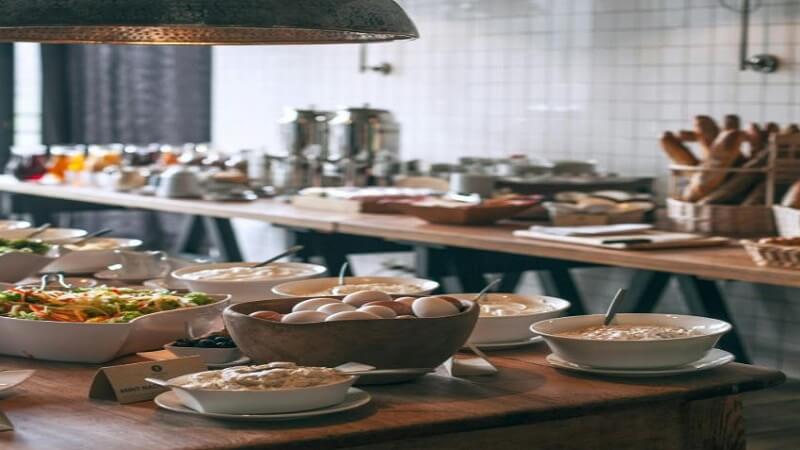Setting up a hotel kitchen isn’t just about buying equipment and hiring chefs. It’s about designing a space that runs smoothly, saves time, and delivers consistent quality. In the fast-paced hospitality industry, efficiency in the kitchen directly impacts guest satisfaction and overall success.
A well-planned, high-efficiency kitchen reduces waste, improves workflow, and helps your team perform at their best, even during peak hours. From layout design to smart technology, every detail matters. Whether you’re opening a new hotel or upgrading an existing kitchen, knowing where to start can be overwhelming.
This guide breaks down the process into clear, practical steps. You’ll learn how to plan your layout, choose the right equipment, and create a kitchen that works like a well-oiled machine.
If you want your hotel kitchen to be productive, safe, and future-ready, keep reading.
Planning Your Hotel Kitchen Layout for Maximum Efficiency
Designing a high-efficiency hotel kitchen starts with a smart layout. The goal is to create a space where staff can move quickly without getting in each other’s way. Divide the kitchen into clear zones—preparation, cooking, cleaning, and storage. Each zone should have its tools and equipment to avoid clutter and confusion. Keep the busiest zones close to each other to reduce movement and save time during service.
Think about the flow of food from service delivery. Ingredients should move in one direction—receiving, storing, prepping, cooking, then plating. Avoid backtracking or overlapping paths. Choose a layout style that suits your space and service type—like assembly line, island, or open kitchen. Make sure aisles are wide enough for carts and staff. Also, follow local safety and health regulations while designing the space. A well-planned layout sets the foundation for smooth operations and faster service.
Choosing the Right Commercial Kitchen Equipment
Choosing the right equipment is key to running a high-efficiency hotel kitchen. Start by listing your menu items and kitchen needs. Focus on equipment that can handle high volume without breaking down. Go for energy-efficient models to save on utility costs in the long run. Look for multipurpose machines like combi ovens, food processors, and tilt skillets to save space and boost productivity.
Always buy from a trusted restaurant supply store to ensure quality and durability. These stores offer commercial-grade products designed for heavy use, including ranges and fryers, refrigeration units, and dishwashers. Ensure the equipment fits your kitchen layout and is easy to clean and maintain. Investing in reliable tools now helps avoid costly breakdowns later.
Optimizing Storage and Refrigeration Solutions
Efficient storage and refrigeration are essential for keeping a hotel kitchen organized and compliant with food safety standards. Start by separating dry, cold, and frozen storage areas. Each section should be easy to access and close to its related work zone. Dry storage should have adjustable shelving for flexibility, while walk-in coolers and freezers should be large enough to handle bulk deliveries. Keep high-use ingredients near prep stations to minimize unnecessary movement.
Proper labeling, inventory rotation, and temperature control are crucial for both safety and efficiency. Use color-coded bins, clear containers, and shelving units that meet health codes. Install commercial refrigeration units that maintain consistent temperatures, even during busy hours. Consider energy-efficient models with digital controls and alarms for temperature changes. Vertical storage units and under-counter fridges can help save space in smaller kitchens. Good storage design prevents cross-contamination, reduces waste, and keeps your kitchen running smoothly. Plan your layout with both workflow and hygiene in mind.
Designing a Seamless Workflow for Staff Productivity
A seamless workflow is the backbone of a high-efficiency hotel kitchen. Begin by assigning clear roles and responsibilities to each staff member. This avoids confusion during peak hours. Organize workstations based on specific tasks—prep, cook, plating, and clean-up. Ensure each station has the tools and ingredients needed for quick and consistent output. Keep commonly used items within easy reach to reduce movement and save time.
Minimize cross-traffic by setting up a logical flow from one station to the next. Staff should be able to move freely without bumping into each other. Use carts, racks, and prep tables with wheels to allow for flexible setup and quick reconfiguration during service. Install proper lighting and ventilation to maintain comfort and visibility. Ergonomic design matters too—height-adjustable tables and anti-fatigue mats help reduce strain during long shifts. When everything is in its place and staff can focus on their tasks, the entire kitchen becomes faster, safer, and more productive.
Implementing Smart Kitchen Technology and Automation
Smart kitchen technology is transforming how hotel kitchens operate. Automated cooking equipment, digital timers, and temperature sensors reduce human error and save time. IoT-enabled devices can monitor usage, track performance, and alert staff before issues arise. This helps avoid unexpected breakdowns and keeps the kitchen running smoothly. Touchscreen controls and programmable settings make operations faster and more consistent, even during rush hours.
Pair smart equipment with the right restaurant supplies to get the most value. For example, use smart refrigerators with labeled containers and digital inventory tools. This ensures better stock control and less food waste. Connect your kitchen equipment to the POS system for real-time updates on orders and prep times. Digital tools also help with maintenance scheduling and energy tracking. These features not only increase efficiency but also support better decision-making. With the right tech and supplies, your kitchen can stay ahead of demand and operate with precision.
Ensuring Hygiene, Safety, and Compliance Standards
Maintaining hygiene and safety in a hotel kitchen is non-negotiable. Start by setting up strict cleaning routines for all workstations, tools, and surfaces. Use food-safe cleaning agents and train staff on proper sanitization techniques. Install handwashing stations at key points throughout the kitchen to encourage regular use. Ensure that all equipment, especially cutting boards and knives, are color-coded to avoid cross-contamination between raw and cooked foods. Proper waste disposal systems should also be in place to keep the kitchen clean and pest-free.
Compliance with health and safety regulations is equally important. Follow HACCP guidelines to identify and manage food safety risks. Equip the kitchen with fire extinguishers, smoke detectors, and ventilation systems that meet industry standards. Non-slip flooring and clear signage help reduce the risk of accidents. Staff should wear proper uniforms, including gloves, aprons, and hairnets. Regular safety drills and inspections help keep everyone prepared and alert. By making hygiene and safety part of daily operations, you protect both your guests and your business.
Conclusion
Setting up a high-efficiency hotel kitchen is a detailed process that requires careful planning, the right equipment, and a strong focus on safety and workflow. From optimizing the kitchen layout to selecting energy-efficient appliances and implementing smart technology, every decision plays a role in creating a productive environment. Efficient storage and refrigeration ensure food safety and minimize waste, while streamlined staff workflows boost productivity during peak times. By maintaining strict hygiene standards and complying with safety regulations, you create a safe, clean space where staff can perform their best. With these key elements in place, your hotel kitchen will be equipped to handle any demand while delivering exceptional service to guests.

